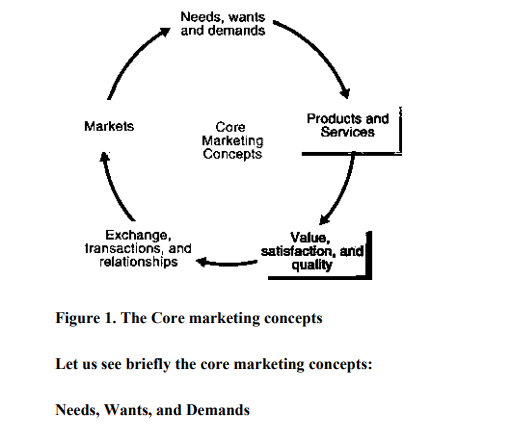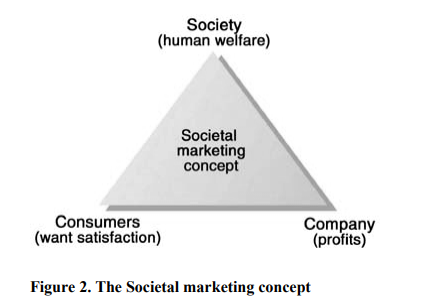1.1 Definition of marketing
There are various definitions of marketing. One of the common definitions is given by Philip Kotler, a marketing professor. According to Kotler, marketing is a system of business activities designed to plan, price, promote and distribute want satisfying goods and services to target markets, in order to achieve organizational objectives. The American Marketing Association (AMA), defines marketing, as approved in 2007, as “the activity, set of institutions, and processes for creating, communicating, delivering, and exchanging offerings that have value for customers, clients, partners, and society at large.”
Marketing is the business function that delivers customer satisfaction at a profit. It creates values for the customers and receives values from the customers in return. Marketing focuses on getting customers, and keeping customers by satisfying their needs. Marketing creates values and satisfaction for the customer. It is the delivery of satisfaction to the customers at a profit.
Marketing as defined above is applicable in all these areas:
- In the profit-making enterprises
- In the government institutions
- In other not-for-profit organizations
1.2 Core marketing concepts
The core marketing concepts help to understand the basic principles of marketing. The core concepts include:
- Needs, wants, demands
- Products and services
- Customer value, satisfaction and quality
- Exchange, transactions and relationships
- Market
The core concepts can be summarized in Figure 1 as shown below:

The most basic concept underlying marketing is that of human needs. Human needs are states of felt deprivation. They include basic physical needs for food, clothing, warmth, and safety; social needs for belonging and affection; and individual needs for knowledge and self-expression. These needs were not invented by marketers; they are a basic part of the human makeup. Wants are the form human needs take as they are shaped by culture and individual personality. An East African needs food but wants Ugali or staple regional dish. Wants are shaped by one’s society and are described in terms of objects that will satisfy needs.
People have almost unlimited wants but limited resources. Thus, they want to choose products that provide the most value and satisfaction for their money. When backed by buying power, wants become demands. Consumers view products as bundles of benefits and choose products that give them the best bundle for their money.
Products and Services
People satisfy their needs and wants with products. A product is anything that can be offered to a market to satisfy a need or want. The concept of product is not limited to physical objects; anything that is capable of satisfying a need can be called a product. In addition to tangible goods, products include the intangible product, such as, services, which are activities or benefits offered for sale that are essentially intangible and do not result in the ownership of anything.
Examples include the services offered by banks, airlines, hotels, lawyers, accounting professionals, doctors, and mechanics.
Generally, the concept product includes:
- Goods ( example, soap, television, mobile handsets)
- Services ( example, haircuts, financial planning, and other product offered by accounts, doctors, painters, musicians, repairers, etc)
- Experiences ( a trip to the peak of Mount Kilimanjaro, Mount Kenya, Lake Turkana, etc.,)
- Persons ( Examples, marathon winners, football stars, etc)
- Places ( example, location spot, cities, such as Masaai Mara, the Caribbean beach, Lake Naivasha, Cape Town, etc.,)
- Organizations ( Red Cross, National bank, etc,)
- Events ( example, World Cup, Olympics)
- Information ( knowledge created and disseminated by universities through teaching and publications; by media through publications, etc., )
- Ideas ( example, “ eat healthy food”; organizations’ or individuals’ doctrines, philosophies, etc., )
Thus, the term product includes much more than just physical goods or services. Consumer decide which events to experience, which dancers to watch on television, which places to visit on vacation, which organizations to support through contributions, and which ideas to adopt. To the consumer, these are all products.
Value, Satisfaction, and Quality
Customer value is the difference between the values the customer gains from owning and using a product and the costs of obtaining the product. Customers often do not judge product values and costs accurately or objectively. They act on perceived value. Customer satisfaction depends on a product’s perceived performance in delivering value relative to a buyer’s expectations. If the product’s performance falls short of the customer’s expectations, the buyer is dissatisfied. If performance matches expectations, the buyer is satisfied. If performance exceeds expectations, the buyer is delighted. Satisfied customers make repeat purchases, and they tell others about their good experiences with the product. The key is to match customer expectations with company performance. Customer satisfaction is closely linked to quality. In recent years, many companies have adopted total quality management (TQM) programs, designed to constantly improve the quality of their products, services, and marketing processes. Quality has a direct impact on product performance and hence on customer satisfaction.
Exchange, Transactions, and Relationships
Marketing occurs when people decide to satisfy needs and wants through exchange. Exchange is the act of obtaining a desired object from someone by offering something in return. Exchange is only one of many ways that people can obtain a desired object.
Exchange allows a society to produce much more than it would with any alternative system. Whereas exchange is the core concept of marketing, a transaction, in turn, is marketing’s unit of measurement. A transaction consists of a trade of values between two parties: One party gives money; another part, say, gets books in return.
Beyond creating short-term transactions, marketers need to build long-term relationships with valued customers, distributors, dealers, suppliers and others. They want to build strong economic and social connections by promising and consistently delivering high-quality products, and fair prices. Increasingly, marketing is shifting from trying to maximize the profit on each individual transaction to building mutually beneficial relationships with consumers and other parties, such as customers, employees, suppliers, distributors, and retailers.
Markets
The concepts of exchange and relationships lead to the concept of a market. A market is the set of actual and potential buyers of a product. The size of a market depends on the number of people who exhibit the need, have resources to engage in exchange, and are willing to offer these resources in exchange for what they want.
1.3 Marketing Management Philosophies
There are major five alternative marketing management philosophies or often which are also known as alternative marketing orientations or concepts under which organizations conduct their marketing activities. These are
- The production concept
- The product concept
- The marketing- orientation/concept
- The societal marketing concept1
1. The Production Concept
The production concept holds that consumers will favor products that are available and highly affordable. Therefore, management should focus on improving production and distribution efficiency. This concept is one of the oldest philosophies that guide sellers. The production concept is still a useful philosophy in two types of situations. The first occurs when the demand for a product exceeds the supply. Here, management should look for ways to increase production. The second situation occurs when the product’s cost is too high and improved productivity is needed to bring it down.
2. The Product Concept
Another major concept guiding sellers, the product concept, holds that consumers will favor products that offer the most in quality, performance, and innovative features. Thus, an organization should devote energy to making continuous product improvements. The product concept can lead to marketing myopia.
3. The Selling Concept
Many organizations follow the selling concept, which holds that consumers will not buy enough of the organization’s products unless it undertakes a large-scale selling and promotion effort. The concept is typically practiced with unsought goods—those that buyers do not normally think of buying, such as encyclopedias or insurance. Most firms practice the selling concept when they have overcapacity. Their aim is to sell what they make rather than make what the market wants. Such marketing carries high risks. It focuses on creating sales transactions rather than on building long-term, profitable relationships with customers. It assumes that customers who are coaxed into buying the product will like it. Or, if they don’t like it, they will possibly forget their disappointment and buy it again later. These are usually poor assumptions to make about buyers. Most studies show that dissatisfied customers do not buy again.
4. The Marketing Concept
The marketing concept holds that achieving organizational goals depends on determining the needs and wants of target markets and delivering the desired satisfactions more effectively and efficiently than competitors do. The selling concept and the marketing concept are sometimes confused. The selling concept takes an inside-out perspective. It starts with the factory, focuses on the company’s existing products, and calls for heavy selling and promotion to obtain profitable sales. It focuses primarily on customer conquest—getting short-term sales with little concern about who buys or why. In contrast, many companies claim to practice the marketing concept but do not. They have the forms of marketing, such as a marketing vice president, product managers, marketing plans, and
marketing research, but this does not mean that they are market-focused and customer-driven companies. The question is whether they are finely tuned to changing customer needs and competitor strategies. Implementing the marketing concept often means more than simply responding to customers’ stated desires and obvious needs. Customer-driven companies research current customers to learn about their desires, gather new product and service ideas, and test proposed product improvements. Such customer-driven marketing usually works well when a clear need exists and when customers know what they want.
The Societal Marketing Concept
The societal marketing concept holds that the organization should determine the needs, wants, and interests of target markets. It should then deliver superior value to customers in a way that maintains or improves the consumer’s and the society’s well being. The societal marketing concept is the latest of the five marketing management philosophies. The societal marketing concept questions whether the pure marketing concept is adequate in an age of environmental problems, resource shortages, rapid population growth, worldwide economic problems, and neglected social services. It asks if the firm that senses, serves, and satisfies individual wants is always doing what’s best for consumers and society in the long run.
Figure 2 summaries the societal marketing concept; it shows the need for linking and balancing the interests of society, the company and consumers.

